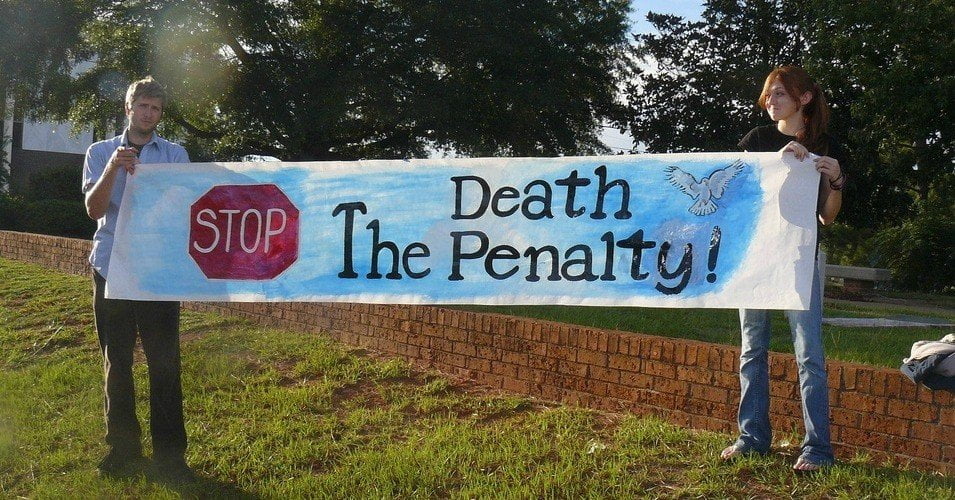From CommonDreams
Each Inmate Awaiting Execution on Trump’s Watch Is a Person—One Whose Life Story Cries Out for Mercy
No matter how terrible the crime, God-like decisions of life or death at the hands of government officials are too weighty and unwieldy for humans to handle.

It’s time for us, awake to the inviolable dignity of all human beings, even those who have committed terrible crimes, to remove that power from the hands of those who should never have been entrusted with it in the first place.(Photo: Kurt and Sybilla/ cc/ Flickr)
The Trump administration is engaged in a full-court press to execute as many people on federal death row as possible before Jan. 20. Attorney General William P. Barr has already overseen eight executions since July. Five more are scheduled before the inauguration of President-elect Joe Biden, who has pledged to end the federal death penalty. This killing spree by a lame-duck president is unmatched in modern U.S. history.
Admittedly, those awaiting federal execution this month and next were found guilty of unspeakable crimes: One man tortured and killed his 2-year-old daughter; another was involved in the murder of a husband and wife, who were shot, then stuffed in the trunk of a car that was set on fire. A third, a gang member, was convicted in seven murders; and a fourth man was said to have been the ringleader in the shooting deaths of three women.
Such horrific crimes make our blood run cold, and within us a righteous voice rises: These killers deserve to die.
But here’s the inscrutable part of these life-and-death decisions. Prosecutors and juries must also consider mitigating circumstances that may move the jury to choose mercy. Each of the people awaiting death on Trump’s watch is a person — one whose life story cries out for mercy. Are we ready for the government to kill these people in our names?
“Lisa is not the ‘worst of the worst,’ she is the most broken of the broken.”
The lone woman scheduled to die is Lisa Montgomery. She killed a mother and kidnapped her baby, after cutting the 8-month fetus out of her victim’s body. But Montgomery is also a human being who suffered appalling abuse starting at birth and continuing throughout her life — abuse so severe it caused a psychotic break. When she cried out for help, help was denied her, and, lost in her own special hell, she committed her horrific crimes. Montgomery desperately needed intensive antipsychotic medication and intensive therapy; today, instead, she faces a fatal needle on Jan. 12, a mere eight days before Biden becomes president.
Sandra Babcock, the human rights attorney leading Montgomery’s clemency appeal, quoted Montgomery’s half-sister to describe her client: “Lisa is not the ‘worst of the worst,’ she is the most broken of the broken.”
Like Montgomery’s, the crimes of the four others scheduled to be executed in December and January are horrifying, yet their paths to the death chamber exemplify a federal death-penalty system that is beyond repair. Two of the men are said to have intellectual disabilities that should have made them ineligible for the death penalty. Another, Brandon Bernard, was 18 when he was involved in the murders of two youth ministers — a husband and wife — in 1999. Bernard would be the youngest person executed by the federal government in nearly 70 years. Still another was convicted in the shooting deaths of three women, but he didn’t fire the shots; the gunman received a sentence of life in prison without parole. Do these men deserve mercy? If they had been tried before a different judge or jury, would they have received life sentences instead?
The outgoing administration’s actions on capital punishment are diametrically opposed to the thrust toward justice in this country. In the past 15 years, we have shut down state killing chambers at a steady pace, as more and more of us have come to recognize the injustices and mistakes riddling the capital punishment system. Since 1973, 172 wrongfully convicted death-row prisoners have been lucky enough to be exonerated. Our track record of mistakes is so abysmal that, for every 10 people executed since 1977, one wrongfully sentenced-to-death person has been set free. And, even as the federal government sets out to execute 10 people in the last six months of 2020, only seven state executions have taken place, the lowest number since 1983.
Over the past 35 years, I have tracked the evolution of the consciousness of my fellow citizens on this crucial human rights issue. What I have found in my discussions with thousands of people, and what the polls show, is that our attitudes toward government killings have shifted dramatically. The year after my book “Dead Man Walking” was published in 1993, fully 80 percent of Americans approved of the death penalty. In contrast, a 2019 Gallup poll revealed that, when given a choice between the death penalty or a sentence of life without parole, only 36 percent of Americans favor death.
The recent spate of government-sponsored killings at the Trump administration’s direction reveals what is most flawed in our nation’s practice of the death penalty: No matter how terrible the crime, God-like decisions of life or death at the hands of government officials are too weighty and unwieldy for humans to handle.
It’s time for us, awake to the inviolable dignity of all human beings, even those who have committed terrible crimes, to remove that power from the hands of those who should never have been entrusted with it in the first place.
This is the world we live in. This is the world we cover.
Because of people like you, another world is possible. There are many battles to be won, but we will battle them together—all of us. Common Dreams is not your normal news site. We don’t survive on clicks. We don’t want advertising dollars. We want the world to be a better place. But we can’t do it alone. It doesn’t work that way. We need you. If you can help today—because every gift of every size matters—please do. Without Your Support We Simply Don’t Exist.
Please select a donation method:




